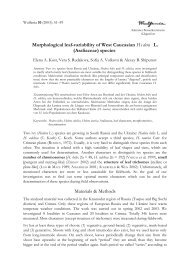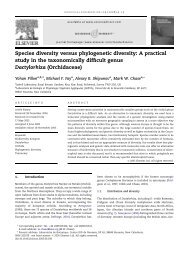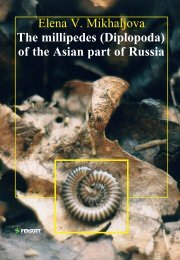Advanced Cell Biology. Lecture 31 - Materials of Alexey Shipunov
Advanced Cell Biology. Lecture 31 - Materials of Alexey Shipunov
Advanced Cell Biology. Lecture 31 - Materials of Alexey Shipunov
Create successful ePaper yourself
Turn your PDF publications into a flip-book with our unique Google optimized e-Paper software.
<strong>Advanced</strong> <strong>Cell</strong> <strong>Biology</strong>. <strong>Lecture</strong> <strong>31</strong><strong>Alexey</strong> <strong>Shipunov</strong>Minot State UniversityApril 17, 2013<strong>Shipunov</strong> (MSU) <strong>Advanced</strong> <strong>Cell</strong> <strong>Biology</strong>. <strong>Lecture</strong> <strong>31</strong> April 17, 2013 1 / 24
OutlineQuestions and answersMembrane transportMembrane potentialSignaling in nerve cells<strong>Shipunov</strong> (MSU) <strong>Advanced</strong> <strong>Cell</strong> <strong>Biology</strong>. <strong>Lecture</strong> <strong>31</strong> April 17, 2013 2 / 24
OutlineQuestions and answersMembrane transportMembrane potentialSignaling in nerve cells<strong>Shipunov</strong> (MSU) <strong>Advanced</strong> <strong>Cell</strong> <strong>Biology</strong>. <strong>Lecture</strong> <strong>31</strong> April 17, 2013 2 / 24
Questions and answersPrevious final question: the answerWhat is a difference between plant and animal cells in concentration <strong>of</strong>ions outside and inside cell?<strong>Shipunov</strong> (MSU) <strong>Advanced</strong> <strong>Cell</strong> <strong>Biology</strong>. <strong>Lecture</strong> <strong>31</strong> April 17, 2013 3 / 24
Questions and answersPrevious final question: the answerWhat is a difference between plant and animal cells in concentration <strong>of</strong>ions outside and inside cell?◮ H + inequality versus K + /Na + and Ca 2+ inequalities, respectively<strong>Shipunov</strong> (MSU) <strong>Advanced</strong> <strong>Cell</strong> <strong>Biology</strong>. <strong>Lecture</strong> <strong>31</strong> April 17, 2013 3 / 24
Membrane transportMembrane potentialMembrane transportMembrane potential<strong>Shipunov</strong> (MSU) <strong>Advanced</strong> <strong>Cell</strong> <strong>Biology</strong>. <strong>Lecture</strong> <strong>31</strong> April 17, 2013 4 / 24
Membrane transportMembrane potentialOrigin <strong>of</strong> membrane potential◮ Normally, K + leak channels are open randomly and let K + tomove freely◮ However, there are still much more K + inside than outsidebecause when it leaks out, electric force will stop this process atsome point◮ This point is a resting potential, ≈–20–200 mV<strong>Shipunov</strong> (MSU) <strong>Advanced</strong> <strong>Cell</strong> <strong>Biology</strong>. <strong>Lecture</strong> <strong>31</strong> April 17, 2013 5 / 24
Membrane transportMembrane potentialK + leak channels support -60 mV resting potential<strong>Shipunov</strong> (MSU) <strong>Advanced</strong> <strong>Cell</strong> <strong>Biology</strong>. <strong>Lecture</strong> <strong>31</strong> April 17, 2013 6 / 24
Membrane transportSignaling in nerve cellsMembrane transportSignaling in nerve cells<strong>Shipunov</strong> (MSU) <strong>Advanced</strong> <strong>Cell</strong> <strong>Biology</strong>. <strong>Lecture</strong> <strong>31</strong> April 17, 2013 8 / 24
Membrane transportSignaling in nerve cellsNerve cells◮ Neurons◮ Axons distribute signals and ends with nerve terminals◮ Dendrites are short branches which receive signals<strong>Shipunov</strong> (MSU) <strong>Advanced</strong> <strong>Cell</strong> <strong>Biology</strong>. <strong>Lecture</strong> <strong>31</strong> April 17, 2013 9 / 24
Membrane transportSignaling in nerve cellsGiant axons <strong>of</strong> squids◮ Atlantic squid, Loligo pealei has extremely long and thick axons(up to 10 cm in length and 1 mm diameter)◮ This was an excellent model for studying nerve cells and signals◮ Alan Hodgkin and Andrew Huxley received 1963 Nobel Prize fortheir investigations with giant axons<strong>Shipunov</strong> (MSU) <strong>Advanced</strong> <strong>Cell</strong> <strong>Biology</strong>. <strong>Lecture</strong> <strong>31</strong> April 17, 2013 10 / 24
Membrane transportSignaling in nerve cellsAtlantic squid<strong>Shipunov</strong> (MSU) <strong>Advanced</strong> <strong>Cell</strong> <strong>Biology</strong>. <strong>Lecture</strong> <strong>31</strong> April 17, 2013 11 / 24
Membrane transportSignaling in nerve cellsAction potential and Na + channels◮ Depolarization <strong>of</strong> neighbor region is a stimulus which opens Na +channels and initiate rapid movement <strong>of</strong> these ions into cell◮ Membrane potential changes from ≈–60 to ≈+40 mV and Na +channels inactivate◮ Then, voltage-gated K + channels are open, K + leaks out <strong>of</strong> celland potential (but not ions!) restores◮ Then, Na + channels close and Na + /K + pump restore ionconcentration to default values<strong>Shipunov</strong> (MSU) <strong>Advanced</strong> <strong>Cell</strong> <strong>Biology</strong>. <strong>Lecture</strong> <strong>31</strong> April 17, 2013 12 / 24
Membrane transportSignaling in nerve cellsAction potential<strong>Shipunov</strong> (MSU) <strong>Advanced</strong> <strong>Cell</strong> <strong>Biology</strong>. <strong>Lecture</strong> <strong>31</strong> April 17, 2013 13 / 24
Membrane transportSignaling in nerve cellsExplanation <strong>of</strong> action potentialWhere K + channels are open?<strong>Shipunov</strong> (MSU) <strong>Advanced</strong> <strong>Cell</strong> <strong>Biology</strong>. <strong>Lecture</strong> <strong>31</strong> April 17, 2013 14 / 24
Membrane transportSignaling in nerve cellsNa + channel cycle<strong>Shipunov</strong> (MSU) <strong>Advanced</strong> <strong>Cell</strong> <strong>Biology</strong>. <strong>Lecture</strong> <strong>31</strong> April 17, 2013 15 / 24
Membrane transportSignaling in nerve cellsAction potential movie<strong>Shipunov</strong> (MSU) <strong>Advanced</strong> <strong>Cell</strong> <strong>Biology</strong>. <strong>Lecture</strong> <strong>31</strong> April 17, 2013 16 / 24
Membrane transportSignaling in nerve cellsPropagation <strong>of</strong> action potential<strong>Shipunov</strong> (MSU) <strong>Advanced</strong> <strong>Cell</strong> <strong>Biology</strong>. <strong>Lecture</strong> <strong>31</strong> April 17, 2013 17 / 24
Membrane transportSignaling in nerve cellsCa 2+ channels and synapses◮ Synapse converts electrochemical signal to pure chemical◮ Depolarization <strong>of</strong> presynaptic membrane will cause Ca 2+channels to open, increase calcium concentration inside cell andinitiate fusion <strong>of</strong> synaptic vesicles to the membrane◮ Fusion should be quickly stopped (one <strong>of</strong> mechanisms isretro-neurotransmitters like endocannabinoids)<strong>Shipunov</strong> (MSU) <strong>Advanced</strong> <strong>Cell</strong> <strong>Biology</strong>. <strong>Lecture</strong> <strong>31</strong> April 17, 2013 18 / 24
Membrane transportSignaling in nerve cellsTransmitter-gated channels◮ Neurotransmitter (small molecule <strong>of</strong> given configuration) crossessynaptic cleft and binds to ligand-gated receptors◮ In synaptic junctions between nerve and muscle cells,acetylcholine neurotransmitter will bind to receprots inpostsynaptic muscle cells◮ Neurotransmitters need to be quickly destroyed (many poisonslike kurare will block this destruction)<strong>Shipunov</strong> (MSU) <strong>Advanced</strong> <strong>Cell</strong> <strong>Biology</strong>. <strong>Lecture</strong> <strong>31</strong> April 17, 2013 19 / 24
Membrane transportSignaling in nerve cellsSynaptic communication (Part I)<strong>Shipunov</strong> (MSU) <strong>Advanced</strong> <strong>Cell</strong> <strong>Biology</strong>. <strong>Lecture</strong> <strong>31</strong> April 17, 2013 20 / 24
Membrane transportSignaling in nerve cellsSynaptic communication (Part II)<strong>Shipunov</strong> (MSU) <strong>Advanced</strong> <strong>Cell</strong> <strong>Biology</strong>. <strong>Lecture</strong> <strong>31</strong> April 17, 2013 21 / 24
Membrane transportSignaling in nerve cellsFinal question (3 points)<strong>Shipunov</strong> (MSU) <strong>Advanced</strong> <strong>Cell</strong> <strong>Biology</strong>. <strong>Lecture</strong> <strong>31</strong> April 17, 2013 22 / 24
Membrane transportSignaling in nerve cellsFinal question (3 points)What is wrong in this picture?<strong>Shipunov</strong> (MSU) <strong>Advanced</strong> <strong>Cell</strong> <strong>Biology</strong>. <strong>Lecture</strong> <strong>31</strong> April 17, 2013 22 / 24
Membrane transportSignaling in nerve cellsSummary◮ Membrane potential is a result <strong>of</strong> unequal distribution <strong>of</strong> electriccharge across a membrane◮ Action potential is due to opening, deactivating and closing <strong>of</strong> Na +channels<strong>Shipunov</strong> (MSU) <strong>Advanced</strong> <strong>Cell</strong> <strong>Biology</strong>. <strong>Lecture</strong> <strong>31</strong> April 17, 2013 23 / 24
Membrane transportSignaling in nerve cellsFor Further ReadingA. <strong>Shipunov</strong>.<strong>Advanced</strong> <strong>Cell</strong> <strong>Biology</strong> [Electronic resource].2011—onwards.Mode <strong>of</strong> access:http://ashipunov.info/shipunov/school/biol_250B. Alberts et al.Essential <strong>Cell</strong> <strong>Biology</strong>. 3rd edition.Garland Science, 2009.Chapter 12.<strong>Shipunov</strong> (MSU) <strong>Advanced</strong> <strong>Cell</strong> <strong>Biology</strong>. <strong>Lecture</strong> <strong>31</strong> April 17, 2013 24 / 24
















